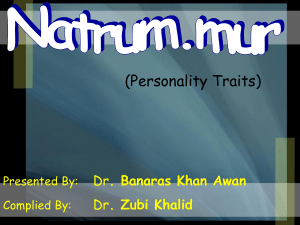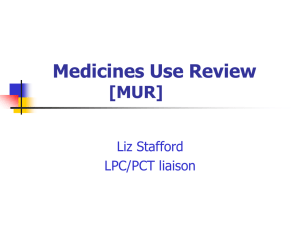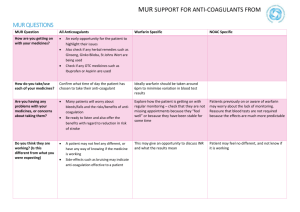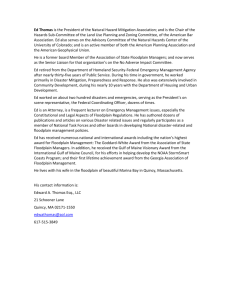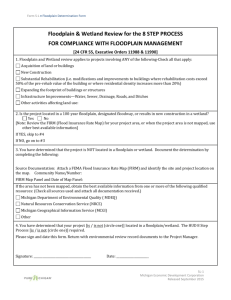WORD english
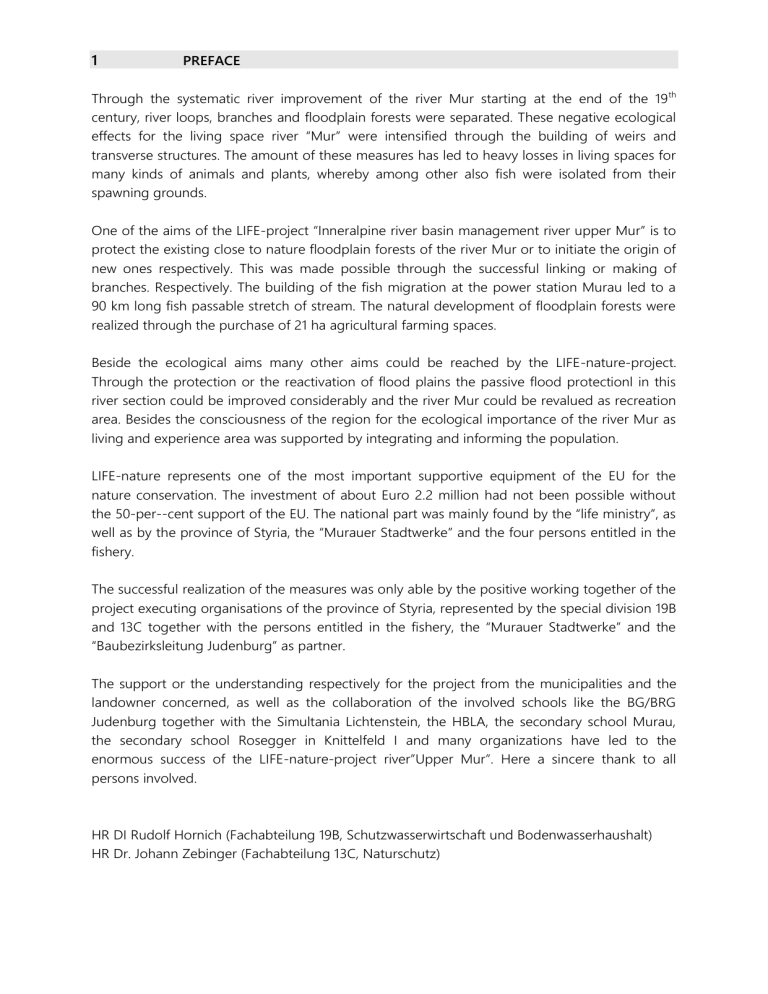
1 PREFACE
Through the systematic river improvement of the river Mur starting at the end of the 19 th century, river loops, branches and floodplain forests were separated. These negative ecological effects for the living space river “Mur” were intensified through the building of weirs and transverse structures. The amount of these measures has led to heavy losses in living spaces for many kinds of animals and plants, whereby among other also fish were isolated from their spawning grounds.
One of the aims of the LIFE-project “Inneralpine river basin management river upper Mur” is to protect the existing close to nature floodplain forests of the river Mur or to initiate the origin of new ones respectively. This was made possible through the successful linking or making of branches. Respectively. The building of the fish migration at the power station Murau led to a
90 km long fish passable stretch of stream. The natural development of floodplain forests were realized through the purchase of 21 ha agricultural farming spaces.
Beside the ecological aims many other aims could be reached by the LIFE-nature-project.
Through the protection or the reactivation of flood plains the passive flood protectionl in this river section could be improved considerably and the river Mur could be revalued as recreation area. Besides the consciousness of the region for the ecological importance of the river Mur as living and experience area was supported by integrating and informing the population.
LIFE-nature represents one of the most important supportive equipment of the EU for the nature conservation. The investment of about Euro 2.2 million had not been possible without the 50-per--cent support of the EU. The national part was mainly found by the “life ministry”, as well as by the province of Styria, the “Murauer Stadtwerke” and the four persons entitled in the fishery.
The successful realization of the measures was only able by the positive working together of the project executing organisations of the province of Styria, represented by the special division 19B and 13C together with the persons entitled in the fishery, the “Murauer Stadtwerke” and the
“Baubezirksleitung Judenburg” as partner.
The support or the understanding respectively for the project from the municipalities and the landowner concerned, as well as the collaboration of the involved schools like the BG/BRG
Judenburg together with the Simultania Lichtenstein, the HBLA, the secondary school Murau, the secondary school Rosegger in Knittelfeld I and many organizations have led to the enormous success of the LIFE-nature-project river”Upper Mur”. Here a sincere thank to all persons involved.
HR DI Rudolf Hornich (Fachabteilung 19B, Schutzwasserwirtschaft und Bodenwasserhaushalt)
HR Dr. Johann Zebinger (Fachabteilung 13C, Naturschutz)
2 “W OS I MOAN ” O PINIONS FROM THE PROJECT AREA
Franz
Karl
Hernus
Sackl
As a farmer one separates heavily from its property. Particularly of the even, well to cultivating valley meadows. The requests of the LIFE-project and the commitment of the BBL employees convinced me finally to give up approximately 4 ha property for the measures in the St. Peterer floodplain forest. Now I have a great pleasure with the converted measures. I also noticed that now more visitors come to the St. Peterer floodplain forest.
That is a sign for me that the measures please also to the population.
In the LIFE-project I represented the interests of Elizabeth von Pezold, person entitled in the fishery. We were involved in the measures in Weyrach and in the St. Peterer floodplain forest. From the fishery point of view through the LIFE-project a substantial contribution was made for the safety and development of the fish existence in the river Mur. As vice-mayor of the municipality Unzmarkt-Frauenburg I understand naturally also the enormous revaluation of the region of the river Mur as local recreation area.
The paddle club "potschnoss" organizes annually recreation vacations for white-russian children, who have radiation damages. The children, who visited us for a recreation vacation in the year 2007 could attend the LIFE final festivity in the Weyrach. There they spent a happy and exciting day in a beautiful nature area. Therefore it particularly makes me happy that I could make a contribution for the realization of some LIFE measures also as person involved in the project. Helmut
Mitterfellner
Helmuth A.
Ploschnitznigg
Franz Walcher
Wolfgang
Auinger
The LIFE-project gives me the possibility to support the contact of the pupils with the nature. Through the school projects the pupils become aware of the importance of the LIFE-measures for the nature. Because we have to go on, if we want to heal the wounds in the nature, which were caused in the past so far as possible, the nature experience in intact places of nature is of great importance. Therefore it is significant for me to make the nature experience more real to the pupils, and not only play “nature” just for one day.
As representative for nature conservation of the “Baubezirksleitung” the
LIFE-project represents for me a milestone for the protection of the biotope and species. If it is possible then to come into very close contact with this project as well and one has the possibility to see with such a variety the nature turned back to the project areas, you have to be enthusiastic completely. The LIFE-project has not only increased the nature region, but has also intensified the esteem for the life area for the river Mur considerably.
As I was responsible for the carrying out of the building projects in the
“Baubezirksleitung Judenburg”, I have got over very labour-intensive, but also successful years. Retrospectively I am proud of the done measures, which revalue the living space “river Mur” for people, animals and plants enormously. Forward-looking I am keen to see how the new Mur-living spaces develop in the next years, how the river Mur form them.
„MUR[ER]LEBEN“
I
NNERALPINE FLUVIAL TOPOGRAPHY MANAGEMENT
R
IVER UPPER
M
UR
PROJECT AREA
3
For the purposes of the European Union support program "LIFE nature" it was strived for under the title "Inneralpine River Basin Management River Upper Mur" the re-establishment or improvement respectively and long-term protection of the close to nature floodplain forest and river landscape. The project area extended over three districts (Murau, Judenburg, Knittelfeld) from the Mur floodplain forest to the region of Knittelfeld.
During the four-year term of the project more than 90 river kilometres were made fish-passable.
Seven branches and tributaries were revitalized or recreated respectively. The "passive flood control" – one of the aims of the flood protection management - could be realized by purchase and reactivation of approximately 17 ha as high water-flooded area.
The total investment volume therefore amounted to approximately Euro 2.2 million, from which
50% was financed by the European Union. The national part was taken over in different parts of the Project executing organisations and project partners, whereby the Federal Ministry for Land and Forestry, Environment and Water Management made available a substantial portion.
W
HAT IS
NATURA 2000
"NATURA 2000" is the European-wide net of thousands nature reserves, by which special animal and plant types as well as habitats worthy for protection should be remained for future generations. This network for nature reserves is to make a substantial contribution on European level to the stop of the global decrease of the biological variety. Basis for the “NATURA 2000” network are two nature protection guidelines of the European Union:
The bird protection guideline
Fauna Flora Habitat (in short: FFH-) directives
The classification of these “NATURA 2000”-areas means a new chance for the domestic nature protection. Measures for preservation or re-establishment of natural habitats for animals and plants can be supported from the " LIFE-nature-program " of the European Union. In the socalled “LIFE nature projects" subsidies of this program are taken up, which supports important nature protection projects throughout Europe. " Mur[er]leben " is a Styrian LIFE-project on the upper river Mur.
4 T HE UPPER R IVER M UR – I MPORTANCE AND THREAT
The 1290 ha large European protected area "upper and central course of the river Mur with
Puxer floodplain forest, Puxer Wand and Gulsen" forms the geographical frame for the project.
The upper river Mur is considered as one of the ecologically most valuable river courses of
Austria. The habitat conditions essentially intact in the upper river Mur makes a natural reproduction possible for the “King of the fish”, the Danube salmon, in the Austrian streams. In
Austria this is otherwise only the case on the Pielach in Lower Austria. Nevertheless development tendencies can be recognized on the upper river Mur through the river improvement and the intensification of use in the valley, which threaten the continuation of the habitats and kinds (see info box "threat for the river Mur"). For example a decrease of the stand of the Danube salmon was to be noticed due to these development tendencies in the last years.
4.1
I NFO BOX " NATURAL RESOURCES ON THE RIVER M UR ":
Danube salmon
The Danube salmon is one of the world-wide largest fresh water fish. In Austria the Danube salmon was originally far common. In Austria today, a stock of the Danube salmon with natural reproduction is, however, present only on the upper river Mur, the river Drau and the lower
Austrian Pielach. For the protection of the stand of the Danube salmon on the river Mur open sections of running water and feeders with high quality of living spaces are necessary as well as a sufficient supply of booty fish.
Italian crested newt
The female of the Italian crested newt is black coloured with a yellow back strip, the males carry a remarkably serrated crest on the back during the mating season in spring. The Italian crested newt prefers standing spawning water, which are more than 1 m deep and are fishless. They spend a relative long time of about 4 months on average in the standing spawning water compared with most of the other amphibians.
Yellow-bellied toad
The Yellow-bellied toad is a little, warty frog with flattened body and yellow-black spotted lower underside. The frog is considered as a kind of pioneer, as he discovers and uses recreated standing spawning water rapidly. While flood plain pools, source pools and occasionally flown scour belong to the original standing spawning water of the Yellow-bellied toad. The Yellowbellied toad uses landscapes affected by humans for spawning above all wheel traces, cattle through, ditches and drainage ditches. The remarkably coloured underside warns enemies –
Yellow-bellied toads are considered as almost inedible!
Kingfisher
The remarkably coloured kingfisher hunts on slowly flowing or standing waters with a rich offer of small fish. He is a typical "impact diver ", who lies in a waiting position from a hide for booty and dips in a suitable moment very fast into the water. The kingfisher digs nests into steep embankments. The nests are scarcely a meter long tubes with a roundish nest chamber.
Alder-Ashes – Floodplain forest
The alder-ashes – floodplain forest grows on streams. The most frequent wood are various alders, ashes, kinds of pasture and kinds of poplars. This type of forest needs periodically varying water levels including annual inundations.
4.2
I NFO BOX " THREAT FOR THE RIVER M UR ":
Channel improvement
The systematic channel improvement beginning at the end of the 19 th century caused a straightening of the course of the river. River loops, branches and floodplain forests were separated. This means a large habitat loss for the fish and amphibians.
The loss of bed load through the building of power stations and the channel straightening of the course of the river caused furthermore a degrading of the river Mur. This degrading has the consequence that the tributaries do not flow in a similar stream bottominto the river Mur.
Therefore many fish are separated from their spawning areas.
A substantial characteristic of a natural stream is his dynamics. After each larger flood new habitats develop such as gravel banks, branches, floodplain forests ponds etc.. Through the channel improvement and the solid protection of many riverine zones only few possibilities for the origin of new habitats are present on the upper river Mur.
Interruption of the streamcontinuum
The kinds of fish, specific for this type of river – with the Danube salmon (Hucho hucho) as leading kind – are dependent on migrations to the spawning habit. Above all the building of power stations without fish migration assistance in the past means a restriction of the possibilities of the fish migration. This hindrance of the migrations causes a constant reduction of the fish existence in the project area.
Loss of floodplain forests through nature-far forest cultivation
Cultivation measures regarding forestry, which are not adapted to the location lead to a conversion from nature-near stand into nature-far and structure-underdeveloped forests.
Therefore results a constant decrease of the stand of floodplain forests as well as a loss of typical floodplain forests habitats for certain kinds of birds and other floodplain forest-dwellers.
5 M ORE R OOM FOR THE RIVER M UR – M EASURES OF THE LIFE PROJECT
5.1
I F FISH CLIMB STAIRCASES – ASSISTANCE FOR FISH MIGRATION MURAU
Since at the end of October 2004 it is in operation, the fish migration assistance at the power station Murau. The fish migration assistance is one of the first and most important measures, which was realized as part of the LIFE nature project.
On an overall length of 230m 24 natural pool passes and 20 technical vertical s of approximately 9 m for the fish is surmountable. For the closer view of the interior a basin of the fish migration assistance was equipped with a bulletproof glass. Thus, interested visitors can watch the fish during the migration.
Due to difficult spatial conditions, the establishment of the fish migration assistance is, with an investment volume of about 300.000,-- Euro, one of the most cost-intensive part of the entire project. Particularly to emphasize is the innovative character of the project, which the fish migration assistance attains through the combination of a bypassing brook with a technical fish migration assistance.
Technical data to the FWH:
Height of fall to overcome: 9.3 metres
Number of pool passes naturally installed:
Number of slit dams artificially installed:
24 basins
20 basins
Overall length of the fish migration assistance: 230 metres
Endowment-quantity of water of the FWH:
Autumn/winter:
Spring/summer:
150 l/sec.
400 l/sec.
5.2
MAUTHOF
This measure will be realized about 3.5 km downstream from Murau in the municipality Steirisch
Laßnitz (Gestüthof Mauthofbauer) in spring 2007.The left-side of the river Mur is lowered on a width of up to 60m and a length of about 800m over approximately 0,8m. This serves the passive flood protection and the improvement of the ecological condition. On that occasion an irregular relief with roughly preformed gutters will be observed. Consequently a 2.6 ha large gravel surface will be formed, which is frequently flooded. This area offers very good conditions for the development of a natural floodplain forest. The forming of river-type-specific branches and gravel islands is made possible by an irregular area modelling (rough modelling of gutters) and the partial removing of the bank stabilization. Further the construction of a downstream linked branch as valuable winter domancy and retreat area for the fish fauna as well as the construction of three floodplain forest ponds for the support of the amphibians takes place.
5.3
A IBL
Between Triebendorf and Aibl a silted up branch right of the bank was tied up again in winter
2005/2006. An approach to the original structure equipment of the river Mur was reached through the activation of this branch. Additionally left of the bank a little bit downstream of the branch there is a larger floodplain forest area in the public water property. Here the support of typical river structures is planned by the removal of the bank stabilization. An additional support of the development of structures in the river Mur is reached by the installation of groynes.
5.4
E SCHLINGBAUERKEHRE
In the municipality Teufenbach directly downstream to the Eschlingbauerkehre is again tied up a silted up, approx. 280m long, right branch to the river Mur. Thus a natural structure of the river
Mur develops again, which were lost through the degrading. A training structure, left to the bank, is to prevent the silting-up of the branch in the future.
5.5
T HE BRANCH S CHRATTENBERG
In the municipality St. Lorenzen bei Scheifling, approximately one kilometre downstream to the
Eschlingbauerkehre, was again re-activated a right to the bank, separated and filled branch from the river Mur in winter 2007. Through the renunciation of bank and embankment protection the river Mur can form natural waters and river structures.
5.6
H IRSCHFELD
In the municipality Unzmarkt-Frauenburg, in the so-called Hirschfeld, on the right bank of the river Mur, remained a larger floodplain forest preserved. In the summer 2005 a constantly endowed branch of the river Mur was created by linking, partly reforming and sloping of the existing rest of the branch. Further the dynamic development of typical structures of the river
Mur is supported by the partial removal of the bank. Through this measure the stand of the floodplain forest is to be protected and the development of new areas of floodplain forests shall be supported. Besides life and retreat areas for the fish fauna are created.
5.7
W EYRACH
This measure is converted in spring 2007 in the municipalities St. Georgen/Judenburg and Pöls on the left Mur branch. Beginning in the near of the Woellgrabenbachmuendung, a new, approximately 600 m long, branch of the river Mur is established through reinstallation and redevelopment in sections (sloping in level) of a landed branch. Only a “branch” tied up to this new branch downstream represents a valuable winter domancy and retreat area for the fish fauna. Rare amphibian habitats are formed by the activation and reinstallation of ponds of floodplain forests. The removal of the bank protection (about 730 m) gives the river Mur the possibility to develop typical waters and bank structures. On the remaining areas, actually used as meadows (1.3 ha), the development of a natural floodplain forest is supported.
5.8
S T .
P ETERER FLOODPLAIN FOREST AND T IPPELWIESEN
In the St. Peterer floodplain forest (St. Peter/Judenburg and Pöls) at first a branch was established in the year 2004. Through the flood in September 2005 it resulted a 30m long and 60m deep bankscar directly downstream to the intake structure. In the context of the project "Murerleben" thereupon the major part of the inner arch between the branch and the river Mur was taken over into the public water property. Thus, the natural structures could be obtained, which resulted from the flood, instead of re-establishing the condition before the flood. On the opposite bank the bank stabilization of 500m was partly removed. As a result natural waters and bank structures can develop also on the left bank. Two re-activated branches, 600m and 200m long, offer especially young and quiet waters fish valuable habitat. On a 5 ha area a natural floodplain forest can be developed. Two ponds of floodplain forest offer new habitat to amphibians.
5.9
T HALHEIM
A separated branch of the river Mur was again tied up and partly created in spring 2005 downstream to the Mur bridge in the near of Thalheim. Through the selective removal of the existing bank stabilization the river Mur has the possibility to form here again natural bank structures. With the construction measure also forest-ecological measures were realized. A specific spruce and hybrid poplar clearing were executed and by putting woods and root sticks the origin of natural floodplain forest was supported. Spawning facilities for endangered amphibians were created by the reactivation and reorganization of floodplain forest water.
5.10
W EYERN
In the Weyern floodplain forest (downstream of the narrow bridge of the river Mur between
Weyern and Grosslobming) was created on a length of approximately 1.2 km more space for the development of natural river habitats. This was made possible by the installing of two branches.
The islands between the branches and the river Mur are unsecured, whereby the river Mur can form natural waters- and bank structures. In the hinterland ponds of floodplain forest with large shallow water zones were made, which serve as spawning water for amphibians. Only a “branch” tied up to this new branch downstream represents a valuable winter domancy and retreat area for the fish fauna. By replacing of 4 ha of surface areas floodplain forest will naturally develop instead of the existing spruce forests. As well the accessibility to the waters was improved for the population.
5.11
L AING
In the municipality of Spielberg, downstream to Knittelfeld, the river mouth of a tributary was converted fish-passably in winter 2007.
6
6.1
T HE RIVER M UR MAKES SCHOOL – SCHOOL PROJECTS
G
REAT AWARD FOR THE
LIFE
COMMON SCHOOL PROJECT
On 28 June 2007 the lending of the award for the environmental protection 2006 took place in the “Weißen Saal” of the “Grazer Burg” in a festive atmosphere. In the category “Schools” the common school project LIFE Upper River Mur with the project title “Murerleben” obtained the first prize.
Three selected schools of the regions Judenburg, Knittelfeld and Murau have taken part in this common school project. The BG/BRG Judenburg together with the Simultania Lichtenstein distinguished themselves with their designed labels of the river Mur and the milestones, which were put along the 90 river kilometres. Pupils of the HBLA Murau created delicious “Murnockerl” for the LIFE-project and the pupils of the “Roseggerhauptschule Knittelfeld” made to take notice with their fairy tale “Monamur”.
6.2
M URWATER LABELS
Under the heading of Professor Helmuth A. Ploschnitznigg pupils of the grammar school in
Judenburg designed and made "Murwater labels". The miniature bottles were presented pridely to Mr. Seitinger (Landesrat).
6.3
M ILESTONES ALONG THE RIVER M UR A SYMBOLIC WATER BRIDGE ,
WHICH CONNECTS
The project of "milestones" is the largest and most extensive pupil project at which all primary schools (about 17 primary schools ) of the districts Murau, Judenburg and Knittelfeld took part.
Together with an artist of Judenburg, Mr. Helmuth Ploschnitznigg, the pupils painted wood piers. These were put up along the 90 river kilometres and should represent a symbolic water bridge .
6.4
M URNOCKERL
The HBLA Murau, which worked under the executive committee of Mrs. Marianne Duscher, created the "Murnockerln". As part of the opening celebration of the fish migration assistance at the power station Murau in April 2005 the Murnockerl were tried for the first time.
Approximately 300 pieces of Murnockerl were manufactured by the pupils particularly for this event and met large approval with the guests. The prescriptions are published on the project homepage.
6.5
F AIRY TALE TO THE TROUT “M ONA M UR ”
Also the Roseggerhauptschule in the district Knittelfeld thought about the river "Mur". Two classes wrote fairy tales in the German class to the fable figure "Mona Mur". The fairy tales can be downloaded from the project homepage.
6.6
P AINTING AND PLANTING OF THE FISH MIGRATION ASSISTANCE M URAU
The walls of the technical part of the FWH Murau were painted by pupils of the HS Murau.
Along the nature-near pool pond trees were planted.
7
7.1
B
EIM
R
ED
'
N KUMMAN DE LEIT ZSAMM
–
THE
LIFE
CELEBRATIONS
LIFE A
UFEST
On 3 September 2005 a large LIFE-Aufest was organized in the St. Peterer Au. This celebration for families formed the final event for the school projects. Furthermore the realized construction measures were presented in the St. Peter floodplain forest, in the so-called Hirschfeld (in the municipality Unzmarkt Frauenburg) and Thalheim.
Five municipalities (Judenburg, St. Georgen ob Judenburg, Pöls, Unzmarkt-Frauenburg and
St. Peter ob Judenburg) organized the LIFE Aufest together with the LIFE project "Murerleben".
They would like to grant the river Mur the value, which is relevant to this river: namely as intact river area and as local recreation area for everybody.
7.2
LIFE FINAL FESTIVITY
The LIFE final festivity took place at the project area Weyrach. All pupils and the children of the
Simultania Lichtenstein who have carried out projects for the topic “Mur”, as well as all other
persons, who were involved in the success of the project, were invited to this festivity. According to the motto “Experience Day Water” the children could pass an exciting day at the river Mur.
Exciting playing stations about the subject “Water” were fun and entertainment– like rafting boat trips with the club “Potschnoss”, rope skipping with the Bergrettung Judenburg, hand netting and observations with the water microscope , campfire with baking of yeast dough and sausages and so on.
It was a particular pleasure that children from Tschernobyl, White Russia, could take part at the festivity, who are passing their holidays since many years in Styria on the initiative of the club
“Potschnoss”.
PROJECT-PART
ICIPANTS
Project executing organisation of the project Mur[er]leben
Amt der Steiermärkischen Landesregierung
Abteilungen Schutzwasserwirtschaft (FA19B) and Naturschutz (FA13C)
Project-participants Mur[er]leben
Murauer Stadtwerke, Forstdirektion Murau - Fürstlich Schwarzenberg' schen Familienstiftung –
Gemeinschaft der Murfischereiberechtigten Thalheim-Knittelfeld - Fischereiberechtigte Elizabeth von Pezold - Grazer Sportanglerverein.
Contact
Fachabteilung 19B Schutzwasserwirtschaft, Stempfergasse 7, A-8010 Graz:
Dipl.-Ing. Heinz Peter Paar, Tel.: 0316/877-2024, fa19b@stmk.gv.at
Baubezirksleitung Judenburg, Kapellenweg 11, A-8750 Judenburg
Ing. Wolfgang Auinger: Tel.: 03572/83 230-0, bblju@stmk.gv.at
Mag. Franz Walcher: Tel.: 03572/83 230-0, bblju@stmk.gv.at
Further information
Project homepage:
www.murerleben.at
IMPRINT
Publisher: Amt der Steiermärkischen Landesregierung.
Responsible for the content: Dipl. Ing. Rudolf HORNICH, Dr. Reinhold TURK, Amt der
Steiermärkischen Landesregierung, Abteilungen Wasserbau und Naturschutz, Stempfergasse 7 or Karmeliterplatz 2 respectively, 8010 Graz
Conception: freiland Umweltconsulting, organization and layout: cre[art]team.
Printed by: ergänzen
Photo and diagram: Auinger, cre[art]team, freiland, Kammerer, Muhar, Paar, Paill
© Amt der Steiermärkischen Landesregierung, Abteilungen Wasserbau und Naturschutz, First
Edition, 2500 pieces. The production of this folder is supported by the European Union with means of the LIFE Natur Fonds.
